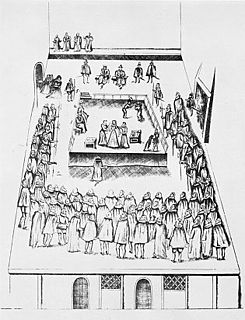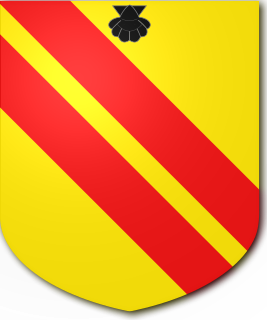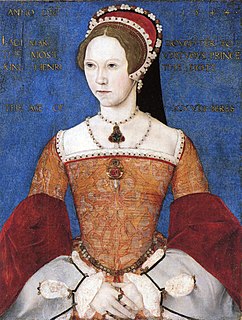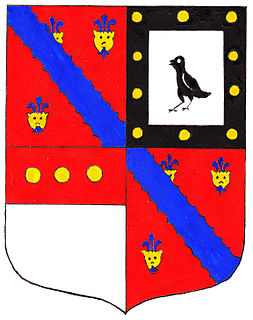This article needs additional citations for verification .(March 2019) |
Richard Tracy (died 1569) was an English lay Protestant reformer and Member of Parliament. [1]
This article needs additional citations for verification .(March 2019) |
Richard Tracy (died 1569) was an English lay Protestant reformer and Member of Parliament. [1]
He was the younger son of William Tracy, a noted Lutheran convert, graduated B.A. at Oxford on 27 June 1515, and was admitted student of the Inner Temple in 1519. In 1529 he was elected to the ‘reformation’ parliament as member for Wotton Basset, Wiltshire. For the next few years he was engaged in the struggle over his father's will.
In February 1533 he was granted Stanway, a manor belonging to Tewkesbury Abbey, which he made the home of his family. He adopted his father's religious views, and appears to have written a short treatise by 1533. In 1535 Tracy's works were classed as dangerous with those of Luther, Melanchthon, William Tyndale, and John Frith. In 1537 Tracy had been placed on the commission of the peace for Gloucestershire, and employed in work connected with the visitation of the monasteries in his shire.
In 1538 he was nominated for the shrievalty, but Henry VIII preferred Robert Acton, and in December 1539 he was appointed one of the squires to attend at the reception of Anne of Cleves. His reforming zeal led his friend and neighbour Hugh Latimer to express a wish that there were many more like him. With Thomas Cromwell's fall Tracy lost favour at court, and on 7 July 1546 his books were ordered to be burnt.
In 1548 he was appointed, under the act for the abolition of chantries, one of the commissioners of inquiry for Gloucestershire. In May 1551 he was imprisoned in the Tower for a letter, probably an attack on Warwick's government. He was released on 17 November 1552. On 9 June 1555 his religious views brought him under the notice of Queen Mary's council, but he cleared himself. On 19 September following, however, he again appeared on a charge of having behaved stubbornly towards the Bishop of Gloucester, and in January 1557 he was in trouble for refusing to pay a forced loan. After Elizabeth's accession Tracy served as High Sheriff of Gloucestershire in 1560–61, and in 1565 wrote a protest to William Cecil against the queen's retaining a crucifix in her chapel.
Probably his ‘Profe and Declaration of thys Proposition: Fayth only iustifieth’, dedicated to Henry VIII, but with no date, place, or printer's name, was Tracy's earliest work. It was followed in 1544 by ‘A Supplycation to our most Soueraigne Lorde, Kynge Henry the Eyght.’
In November 1548, during the discussions in convocation and parliament which preceded the issue of Edward VI's first Book of Common Prayer , Tracy published ‘A Bryef and short Declaracyon made wherebye euery Chrysten Man may knowe what is a Sacrament,’ London. He quotes largely from Augustine of Hippo.
Besides these, Tracy is said to have written ‘The Preparation to the Crosse and to Death .... in two bookes,’ 1540. This treatise, bound up with two by John Frith, was found in a cod's belly in Cambridge market in 1626 (see Vox Piscis ), and was reprinted in that year by Boler and Milbourne.
By his wife Barbara, daughter of Sir Thomas Lucy (died 1525), Tracy had at least six sons and five daughters. The eldest surviving son, Paul Tracy of Stanway, was created a baronet in 1626. In 1543 Bartholomew Traheron, who had been educated at Tracy's expense and was called his son, dedicated to him his translation of John of Vigo's Surgery.

Henry VIII was King of England from 22 April 1509 until his death in 1547. Henry is best known for his six marriages, and for his efforts to have his first marriage annulled. His disagreement with Pope Clement VII about such an annulment led Henry to initiate the English Reformation, separating the Church of England from papal authority. He appointed himself Supreme Head of the Church of England and dissolved convents and monasteries, for which he was excommunicated by the pope. Henry is also known as "the father of the Royal Navy" as he invested heavily in the navy and increased its size from a few to more than 50 ships, and established the Navy Board.

Catherine Parr was Queen of England and Ireland as the last of the six wives of King Henry VIII from their marriage on 12 July 1543 until Henry's death on 28 January 1547. Catherine was the final queen consort of the House of Tudor, and outlived Henry by a year and eight months. With four husbands, she is the most-married English queen. She was the first woman to publish an original work under her own name in English in England.

Sir Nicholas Bacon was Lord Keeper of the Great Seal during the first half of the reign of Queen Elizabeth I of England. He was the father of the philosopher and statesman Sir Francis Bacon.

William TurnerMA was an English divine and reformer, a physician and a natural historian. He has been called "The father of English botany." He studied medicine in Italy, and was a friend of the great Swiss naturalist, Conrad Gessner. He was an early herbalist and ornithologist, and it is in these fields that the most interest lies today. He is known as being one of the first "parson-naturalists" in England.
Edward Hall was an English lawyer and historian, best known for his The Union of the Two Noble and Illustre Families of Lancastre and Yorke—commonly known as Hall's Chronicle—first published in 1548. He was also several times a member of the Parliament of England.

Katherine Brandon, Duchess of Suffolk, suo jure12th Baroness Willoughby de Eresby, was an English noblewoman living at the courts of King Henry VIII, King Edward VI and Queen Elizabeth I. She was the fourth wife of Charles Brandon, 1st Duke of Suffolk, who acted as her legal guardian during his third marriage to Henry VIII's sister Mary. Her second husband was Richard Bertie, a member of her household. Following Charles Brandon's death in 1545, it was rumoured that King Henry had considered marrying Katherine as his seventh wife, while he was still married to his sixth wife, Catherine Parr, who was Katherine's close friend.
Viscount Tracy, of Rathcoole in the County of Dublin, was a title in the Peerage of Ireland. It was created on 12 January 1643 for Sir John Tracy, previously Member of Parliament for Gloucestershire. He was made Baron Tracy, of Rathcoole in the County of Dublin, at the same time, also in the Peerage of Ireland. The second Viscount also represented Gloucestershire in Parliament. The titles are considered to have become extinct on the death of the eighth Viscount in 1797. However, the peerages were the subjects of at least four claims presented to the House of Lords during the 19th century.
Events from the 1530s in England.

Sir William Kingston, KG was an English courtier, soldier and administrator. He was the Constable of the Tower of London during much of the reign of Henry VIII. Among the notable prisoners he was responsible for were Queen Anne Boleyn, as well as the men accused of adultery with her. He was MP for Gloucestershire in 1529 and 1539.
Sir Edward Bayntun, of Bromham, Wiltshire, was a gentleman at the court of Henry VIII of England. He was vice-chamberlain to Anne Boleyn, the King's second wife, and was the brother-in-law of Queen Catherine Howard, Henry VIII's fifth wife.

Robert Beale was an English diplomat, administrator, and antiquary in the reign of Elizabeth I. As Clerk of the Privy Council, Beale wrote the official record of the execution of Mary, Queen of Scots, to which he was an eyewitness.
William Tracy was an English justice of the peace and prominent early Lutheran convert. After his death both his will and his remains became caught up in the struggle around the Protestant Reformation in England.

The Tracy Baronetcy, of Stanway in the County of Gloucester, was a title in the Baronetage of England. It was created on 29 June 1611 for Paul Tracy. He was the eldest son of the lay Protestant reformer Richard Tracy. The title became extinct on the death of the fifth Baronet in 1678. The seat of the Tracy family was Stanway House, Stanway, Gloucestershire.

Miles Huggarde or Myles Hogarde, was an English religious pamphleteer and opponent of the Protestant Reformation. He has been described as the best of Roman Catholic propagandists in the bitter pamphlet war of 1553–1558 during the reign of Queen Mary I.

Sir William Denys (1470–1533) of Dyrham, Gloucestershire, was a courtier of King Henry VIII and High Sheriff of Gloucestershire in 1518 and 1526.
Bartholomew Traheron (1510?–1558?) was an English Protestant writer and Marian exile.

Sir William Courtenay"The Great", of Powderham in Devon, was a leading member of the Devon gentry and a courtier of King Henry VIII having been from September 1512 one of the king's Esquires of the Body. He served as Sheriff of Devon three times: from February to November 1522, 1525/6, and 1533/4. He was elected Knight of the Shire for Devon in 1529.
Sir Anthony Keck was an English lawyer and politician. He was a member of Parliament between 1691 and 1695, and served as Commissioner of the Great Seal from 1689 to 1690.
The historic manor of Iron Acton was a manor centred on the village of Iron Acton in Gloucestershire, England, situated about 9 miles (14 km) north-east of the centre of the City of Bristol. The manor house, known as Acton Court is a Tudor building which survives today, situated at some distance from the village and parish church of St Michael. It was long the principal seat of the prominent Poyntz family, lords of the manor, whose manorial chapel is contained within the parish church.
Sir William Uvedale was an English soldier and courtier.